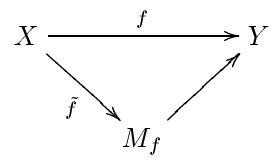 | ||
In mathematics, specifically algebraic topology, the mapping cylinder of a function
Contents
- Basic properties
- Interpretation
- Applications
- Categorical application and interpretation
- Mapping telescope
- References
where the
That is, the mapping cylinder
with the subscripted cup symbol denoting the equivalence. The mapping cylinder is commonly used to construct the mapping cone
Basic properties
The bottom Y is a deformation retract of
(where points in
The map
Interpretation
The mapping cylinder may be viewed as a way to replace an arbitrary map by an equivalent cofibration, in the following sense:
Given a map
Thus the space Y gets replaced with a homotopy equivalent space
gets replaced with a diagram
together with a homotopy equivalence between them.
The construction serves to replace any map of topological spaces by a homotopy equivalent cofibration.
Note that pointwise, a cofibration is a closed inclusion.
Applications
Mapping cylinders are quite common homotopical tools. One use of mapping cylinders is to apply theorems concerning inclusions of spaces to general maps, which might not be injective.
Consequently, theorems or techniques (such as homology, cohomology or homotopy theory) which are only dependent on the homotopy class of spaces and maps involved may be applied to
Another, more intuitive appeal of the construction is that it accords with the usual mental image of a function as "sending" points of
Categorical application and interpretation
One can use the mapping cylinder to construct homotopy colimits: this follows from the general statement that any category with all pushouts and equalizers has all colimits. That is, given a diagram, replace the maps by cofibrations (using the mapping cylinder) and then take the ordinary pointwise limit (one must take a bit more care, but mapping cylinders are a component).
Conversely, the mapping cylinder is the homotopy pushout of the diagram where
Mapping telescope
Given a sequence of maps
the mapping telescope is the homotopical direct limit. If the maps are all already cofibrations (such as for the orthogonal groups
Formally, one defines it as
